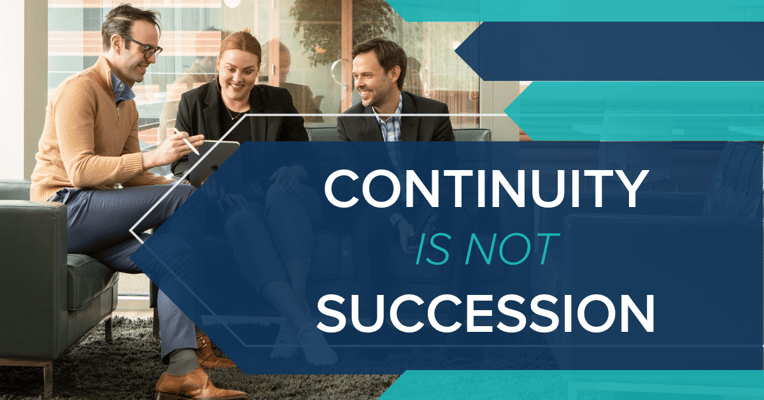Blog
Continuity is Not Succession

Often used interchangeably, the terms Continuity Plan and Succession Plan refer to very different business planning elements. Continuity plays an essential role in defining what happens upon a “triggering event”– sudden absence, disability, death or otherwise, while succession refers to an intentional plan that brings multiple generations of owners into the business, typically over 10-15 years, to carry it forward for decades to come. We refer to this goal as sustainability.
The concept of firm and industry sustainability has been discussed for many years. The reason it continues to be of focus is strongly correlated to the reality that over 25% of advisors planning to retire in the next decade do NOT have a succession plan. This alarming statistic puts our entire industry in jeopardy. Clients expect their advisor to have a viable, well-documented continuity plan – at a minimum – and fortunately more than two-thirds of advisors have some version of this in place. However, a continuity plan is not going to have the same impact as a succession plan.
Our recommendation is that every advisor always have a continuity plan in place and revisit it annually for any adjustments. This continuity plan is important, but it is absolutely not a succession plan. Given that many advisors continue to confuse continuity and succession, we are breaking down the differences.
Think of continuity as your emergency plan. You know that your clients will need someone they can trust, who can step in and support them just as you have. This person needs to make sense in a number of ways. Whether it’s a trusted partner or peer, long-term friend or that advisor down the street, who you select as your continuity partner really matters.
This is why you should absolutely take advantage of the time you do have today. A triggering event does not provide your family/estate, employees or other stakeholders time to vet and test out potential partners as might a traditional merger or acquisition. Identifying a partner who truly fits your business from essential angles ensures a clear path for clients and employees.
Here are a few things you should verify annually with your continuity partner:
#1 – Are they still a good fit?
Who you select as your continuity partner really matters. This is why you should absolutely take advantage of the time you do have today. A triggering event does not provide your family/estate, employees or other stakeholders time to vet and test out potential partners as might a traditional merger or acquisition. Identifying a partner who truly fits your business from essential angles ensures a clear path for clients and employees.
FPT RESOURCE: The Perfect Fit – we cover the six factors of fit in this blog.
#2 – Can they absorb the business?
Aside from agreeing to take on the work of running your business, working with your clients, and paying the bills, can this individual (or team of individuals) actually commit to that added workload? Likely not as-is. We know that the average advisor runs out of capacity at around 100-150 clients. This means an advisor already serving 100 of their own clients certainly cannot flip a switch and take on your additional 150. It’s not physically possible. But this information should spark a solution. If the advisor is willing to absorb your business, there are ways to ensure he can actually do so. Within your continuity agreement, there should be clear parameters around what that looks like - bringing on another advisor, promoting a junior planner, divesting and sharing a portion of clients with another advisory team, etc. There are financial elements to consider, as well as timing, vetting, and notifications that could be proactively outlined. An expert can help you define and address compelling solutions within your continuity agreement.
#3 - Can they afford it?
Assuming you have an annual valuation (or at minimum, every other year), you have a general idea of what the business is worth. Just because you are incapacitated or not participating in the sale of the business doesn’t mean the business is offered at a discount. You firm is a personal asset, and your family should benefit from your care and attention prior to any unforeseen life event.
There are several ways to ensure your partner has the means necessary to purchase your business at a fare, agreed upon price. Additionally, as time changes, their willingness to take on potential debt or make up-front payments might shift with life priorities. Checking back in with them to ensure the plan accommodates any necessary adjustments is important.
FPT RESOURCE: Funding Continuity – a seven-minute video on how to avoid financial chaos in your continuity plan.
#4 – What other intentions do you have?
A continuity plan could include additional actions, requirements or other elements that you clearly define and tee-up to occur upon a triggering event. What this looks like is different for everyone. This is why engaging a professional team that creates continuity plans every week is the easiest way to uncover and solidify your wishes. There are certainly pitfalls in creating complexity, or outlining expectations that are not feasible. Our Equity Management Solutions team stands at the ready to help you navigate all the ‘what ifs’ that arise.
FPT RESOURCE: Six Steps to Building an Effective Continuity Plan
Will a Continuity Plan Be Enough?
If you view your current role as simply a job, rather than a business owner growing a valuable, transferable asset, then a continuity plan could suffice. It’s that perspective shift from job-to-owner where an advisor should begin to build out a succession plan. It really comes down to what you are trying to create and what your ideal career path entails. Our message is simply that clients need to know they will be cared for now and into the future, and a succession plan really ensure this happens in the most ideal way possible.
Succession builds upon your continuity plan, leveraging those fundamental components to power a multi-year journey that empowers additional owners, drives value through growth, and creates a legacy enjoyed by all stakeholders. Succession is you setting the course and seeing it through as a vital captain of the future of the firm. Your commitment is essential, and your financial upside and work-week trajectory likely make this a remarkable experience.
The key elements of moving from Continuity Planning to Succession Planning:
#1 - Set succession as the goal.
Merging, selling, retiring – all of that is Plan B. Continuity is merely the safety net.
Another key difference is that upon a triggering event, you will not be there to oversee what happens to your business. It is sudden and triggers a series of steps that occur in calculated sequence, which is laid out clearly in your continuity plan. Succession plans require significant time and investment from the current ownership team to ensure the new ownership team is prepared, clients are comfortable, and the business is set up for success.
#2 – Develop a culture that attracts successors.
Too often, advisors set out to locate a successor, or bring on talent that they hope to one day merge into a succession plan but they fail to set the foundations that attract, retain, and prepare talented advisors. Before you bring on any advisors or staff that could serve as a successor team, working on your own vision and goals is essential. What kind of firm are you now, and where do you want to be? A well-defined roadmap to success opens the door to fruitful conversations, properly setting expectations and open dialogue at the outset.
Cultivating successor talent is not easy – but it can be incredibly beneficial. Slowing bringing a partner into the business, teaching them your ownership mentality, giving them opportunities to grow and learn, all of this can benefit the entire business. It also gives you time to understand and test this next generation owner’s potential to carry the business forward alongside you for several years. You can do this while maintaining total decision-making control, identifying when and how you want to progress the succession plan at your ideal pace.
#3 – Engage a professional to maximize impact.
You never have to do this alone. In fact, the right partner can leverage experience, data and insights, to optimize your decisions. Building out a succession plan is incredibly complex and nuanced in our industry. While you can certainly outline some of this on your own, the benefit of a partner like FP Transitions is that we go deep, we dive into your goals, and we offer you detailed analysis and show you a variety of options – each with different prioritized outcomes We help advisors navigate their succession plan every day, which makes us experts.
If you have questions about why, when, how or where to start building your succession plan, we’re here for it. Schedule a chat with one of our succession planning experts today.